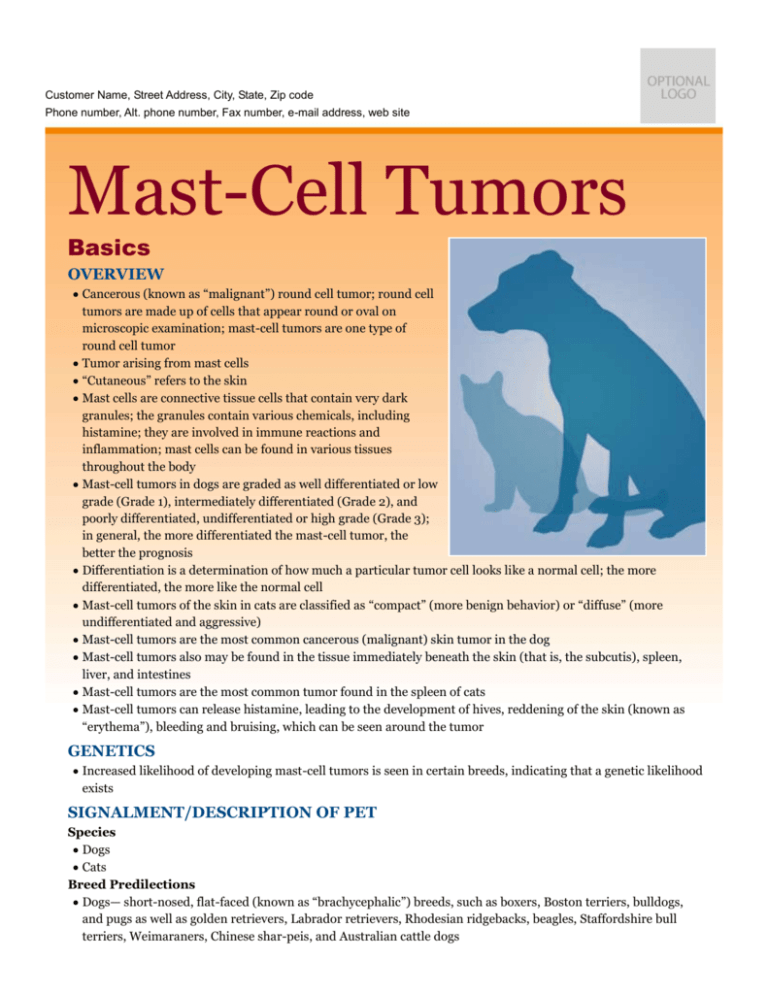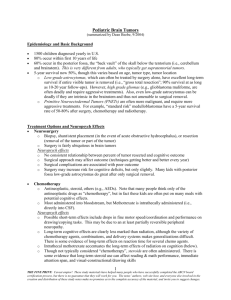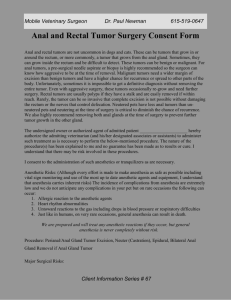mast-cell_tumors
advertisement

Customer Name, Street Address, City, State, Zip code Phone number, Alt. phone number, Fax number, e-mail address, web site Mast-Cell Tumors Basics OVERVIEW • Cancerous (known as “malignant”) round cell tumor; round cell tumors are made up of cells that appear round or oval on microscopic examination; mast-cell tumors are one type of round cell tumor • Tumor arising from mast cells • “Cutaneous” refers to the skin • Mast cells are connective tissue cells that contain very dark granules; the granules contain various chemicals, including histamine; they are involved in immune reactions and inflammation; mast cells can be found in various tissues throughout the body • Mast-cell tumors in dogs are graded as well differentiated or low grade (Grade 1), intermediately differentiated (Grade 2), and poorly differentiated, undifferentiated or high grade (Grade 3); in general, the more differentiated the mast-cell tumor, the better the prognosis • Differentiation is a determination of how much a particular tumor cell looks like a normal cell; the more differentiated, the more like the normal cell • Mast-cell tumors of the skin in cats are classified as “compact” (more benign behavior) or “diffuse” (more undifferentiated and aggressive) • Mast-cell tumors are the most common cancerous (malignant) skin tumor in the dog • Mast-cell tumors also may be found in the tissue immediately beneath the skin (that is, the subcutis), spleen, liver, and intestines • Mast-cell tumors are the most common tumor found in the spleen of cats • Mast-cell tumors can release histamine, leading to the development of hives, reddening of the skin (known as “erythema”), bleeding and bruising, which can be seen around the tumor GENETICS • Increased likelihood of developing mast-cell tumors is seen in certain breeds, indicating that a genetic likelihood exists SIGNALMENT/DESCRIPTION OF PET Species • Dogs • Cats Breed Predilections • Dogs— short-nosed, flat-faced (known as “brachycephalic”) breeds, such as boxers, Boston terriers, bulldogs, and pugs as well as golden retrievers, Labrador retrievers, Rhodesian ridgebacks, beagles, Staffordshire bull terriers, Weimaraners, Chinese shar-peis, and Australian cattle dogs • Cats—Siamese Mean Age and Range • Dogs—middle-aged, range 4 months–18 years of age • Cats—middle-aged, 8–9 years of age for mast-cell tumors affecting the skin (known as “cutaneous mastocytoma”) and older cats for mast-cell tumors found in the intestines or spleen • Cats—histiocytic form of mast-cell tumors of the skin (cutaneous mast-cell tumor) occurs in young cats, mean age of 2.4 years Predominant Sex • Dogs—none • Cats—male Siamese SIGNS/OBSERVED CHANGES IN THE PET • Depend on the location and grade of the tumor Dogs • Tumor on the skin or under the skin (known as “subcutaneous” or “subcutis”), may have been present for days to months • Mast-cell tumors may be present within fatty tumors (known as “lipomas”) • Tumor may have appeared to fluctuate in size • Recent rapid growth after months of inactive or subtle growth is common • Recent onset of redness (known as “erythema”) and fluid buildup (known as “edema”) most common with highgrade skin and subcutaneous tumors • Fluid buildup (edema) may be seen in the area around a tumor that has released histamine and other chemicals (known as “degranulation”) • Lymph nodes may be enlarged in or near the area of the tumor (known as “regional lymphadenopathy”)—may develop when a high-grade tumor spreads (metastasizes) to the lymph nodes • Systemic illness with advanced local or generalized disease; may see vomiting; lack of appetite (known as “anorexia”), weight loss, and black, tarry stools (due to the presence of digested blood; condition known as “melena”) Cats • Lack of appetite (known as “anorexia”)—most common complaint with mast-cell tumor of the spleen • Vomiting and diarrhea—may occur secondary to mast-cell tumors of the spleen or gastrointestinal tract • Long-term (chronic) weight loss • Sluggishness (lethargy) • Mast-cell tumor of the spleen—enlarged spleen (splenomegaly) • Intestinal mast-cell tumor—firm, segmental thickenings of the small intestinal wall; spread (metastasis) to the mesenteric lymph nodes, spleen, liver, and (rarely) lungs CAUSES • Genetic mutation has been identified in up to 30% of mast-cell tumors RISK FACTORS • Hereditary • Certain breeds of dogs and cats are more likely to develop mast-cell tumors (see “Breed Predilections”) Treatment HEALTH CARE Dogs • Surgical removal (excision) of the mast-cell tumor and surrounding tissue—treatment of choice • Conventional recommendations that surgical removal include wide margins (2–3 cm) around the tumor may be unnecessary with Grade 2 mast-cell tumors, as the majority of cases with so-called “dirty margins” (where tumor cells are found by microscopic examination in the edges of the surgically removed tissue) fail to have regrowth of the tumor at the surgical site • Microscopic evaluation of the entire surgically removed tissue—essential to predict the biologic behavior of the tumor and to grade the tumorLymph-node involvement—surgical removal of the affected lymph node(s) and the primary tumor; follow-up chemotherapy may be useful • Radiation therapy—treatment option for mast-cell tumor of the skin that is incompletely removed surgically and in a location that does not allow aggressive surgical removal or in cases where another surgery is not possible • Radiation therapy can be used to treat entire tumor, but severe reactions are possible Cats • Surgery—treatment of choice for mast-cell tumors of the skin; only narrow margins around the removed tumor are necessary, as the majority of tumors do not regrow following narrow surgical margin tumor removal • Surgical removal of the spleen (known as “splenectomy”)—treatment of choice for mast-cell tumors of the spleen; splenectomy is recommended in cats with large tumor burden in the abdomen, despite spread of the cancer (metastasis) ACTIVITY • Limit activity for pets with heavy tumor burden (such as cats with mast-cell tumors of the intestines or spleen) Medications • Medications presented in this section are intended to provide general information about possible treatment. The treatment for a particular condition may evolve as medical advances are made; therefore, the medications should not be considered as all inclusive DOGS • Vinblastine and prednisone • Vinblastine only • Lomustine • Torcerinib • Masitinib CATS • Lomustine • Vinblastine DOGS AND CATS • Symptomatic treatment—Benadryl; famotidine or other histamine-blocking (H2) agents; omeprazole and sucralfate should be considered for any dog or cat with gross mast-cell disease Follow-Up Care PATIENT MONITORING • Evaluate any new masses microscopically • Evaluate regional lymph nodes at regular intervals to detect spread (metastasis) • Check complete blood count (CBC) at regular intervals, if the pet is receiving chemotherapy • Check liver enzymes on serum biochemistry profile, if the pet is on certain chemotherapy drug protocols (such as lomustine therapy) Dogs • Grade 1 or 2—complete surgical removal should be curative in the majority of affected pets • Grade 2 (high)—complete surgical removal evaluated every 3 months for 1 year with physical examination, abdominal ultrasound, and lymph-node assessment • High-grade tumors (Grade 3 or those in a location associated with a negative prognosis)—physical examination, bloodwork (such as complete blood count [CBC] and serum biochemistry profile) and abdominal ultrasound every 2 months for 1 year and then every 6 months for an additional 2 years Cats • Abdominal, including mast-cell tumor involving the intestine or spleen—abdominal ultrasound every 3 months for 1 year POSSIBLE COMPLICATIONS • Low white blood cell count (known as “leucopenia”) due to suppression of the bone marrow (known as “myelosuppression”) secondary to chemotherapy • Liver toxicity (known as “hepatotoxicity”) EXPECTED COURSE AND PROGNOSIS • complete surgical removal (excision) of low-grade mast-cell tumors in most locations is curative • Complete surgical removal (excision) of high-grade mast-cell tumors or those located in areas associated with a poor prognosis (mucocutaneous junctions [areas where skin and moist tissues of the body come together; for example, the lips]), possibly inguinal regions) often require chemotherapy; median survival times averages approximately 11–12 months • Incomplete surgical removal (excision) of a low-grade mast-cell tumor may require additional local therapy with another surgery (often cured) or radiation therapy (85% disease-free at 3 years) • Incomplete surgical removal (excision) of a high-grade mast-cell tumor requires additional local therapy, in addition to chemotherapy; median survival times range from 6 to 12 months • Spread of the cancer to lymph nodes in the area of the tumor (regional metastasis) should be treated with surgical removal (excision) of the affected lymph node(s) at the time of the primary tumor removal; chemotherapy is necessary; median survival times are typically less than 9 months • Spread of the cancer to lymph nodes located away from the tumor or other organs (known as “distant metastasis”) often is treated with chemotherapy or ancillary therapies alone with a median survival of 4 months or less Key Points • Fourteen to seventeen percent of dogs diagnosed with a mast-cell tumor will have two or more unrelated mastcell tumors in their lifetimes; each of these has the potential for being cured with appropriate surgical intervention • All new masses should be evaluated by a veterinarian • Fine-needle aspiration and microscopic examination should be performed as soon as possible on any new mass • Surgical removal (excision) should be done as soon as possible on any new mast-cell tumor Enter notes here Blackwell's Five-Minute Veterinary Consult: Canine and Feline, Fifth Edition, Larry P. Tilley and Francis W.K. Smith, Jr. © 2011 John Wiley & Sons, Inc.









